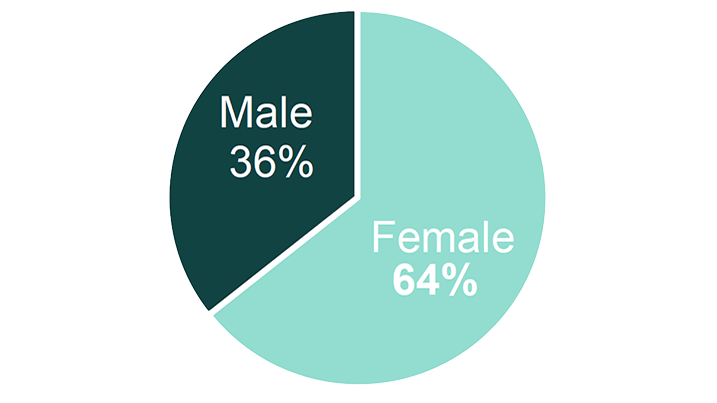Gender pay reporting
In the UK, public, private and voluntary sector organisations with 250 or more employees must report on their gender pay gaps annually (2024 will be the 8th cycle of reporting). The report shows the difference between the average earnings of men and women expressed relative to men’s earnings.
A gender pay gap doesn’t mean women are paid less than men for doing the same job within the organisation, but it does show that on average, men occupy higher-paying roles than women.
Where we are and why
At the snapshot date of 5 April 2024, WWT’s workforce consisted of 569 employees and casual workers with 35.7% being male and 64.3% being female.

Our gender pay gap report reveals a 7.97% pay gap between the average pay of men and women and a 4.9% pay gap exists when looking at the median (mid-point) level of pay for our male and female workers.
Both our mean average and our median average gender pay gaps have approximately halved over a five year period.
| 2020 | 2021 | 2022 | 2023 | 2024 | |
|---|---|---|---|---|---|
|
Mean gender pay gap (the average hourly rate) |
14.86% | 12.77% | 11.44% | 9.86% | 7.97% |
|
Median Gender Pay Gap (the mid point hourly rate when listed in order) |
11.67% | 11.93% | 13.69% | 5.23% | 4.90% |
The Office for National Statistics (ONS) Annual Survey of Hours and Earnings reports that the average mean gender pay gap for not-for-profit organisations is 14.7% and the average median pay gap is 16.1% (Office for National Statistics 2024). Our gender pay gap results fall well below these averages for our sector.
For gender pay gap reporting, we’re also required to divide our paid workers into four quartiles by hourly rate and to show proportion of men and women in each quartile at the snapshot date.

An explanation for our continuing gender pay gap is that we employ more women than men in part-time roles and casual worker positions and more of these roles exist at our lower paid grades.
As a means of encouraging and supporting all employees who may need to balance their employment with other commitments we offer, wherever possible, flexible and hybrid working arrangements. This year has seen another increase in the percentage of women represented in our upper two quartiles. As of April 2024, 4 out of our 6 most senior leadership roles were held by women.
Bonuses
WWT’s mean and median bonus pay gap is 0%, with no males or females receiving a bonus in 2024.
Paying the same for doing the same job
It’s important to note that the gender pay gap is not a measure of the difference in pay between men and women doing the same job. Within WWT, men and women are paid equally at the same grade for doing equivalent jobs and where differences occur through the payment of market forces, they are justifiable.
What we’re doing to improve our gender pay gap
Actions taken in 2023/2024
- Embedded Diversity, Inclusion and Belonging into our 2030 strategy acknowledging that it is one of the core areas where we want to increase our efforts and impact.
- Continued to promote flexible and hybrid working which give more flexible options to enable colleagues at all levels within WWT to work in a way that suits their personal needs.
- Increased the number of secondment opportunities being available internally to support career opportunities and progression within WWT.
- Developed a framework for our Early Career pathways to enable people to gain entry to employment at WWT through a broader range of opportunities.
- Introduced paid student placement opportunities to break down barriers and create new opportunities for people from all walks of life to have a fulfilling career in conservation.
Actions we are taking in 2024/25
- Conduct a WWT wide Equity, Diversity and Inclusion audit with an external third party to understand their findings and establish an action plan to implement recommendations.
- Develop a values and behaviours framework to support our Thrive ambitions and embed this within our people lifecycle to support everyone at WWT to feel empowered and engaged.
- Focusing on our data – we will develop reporting and gather data to develop a greater understanding of recruitment and progression within WWT to help us to identify any barriers and challenges we need to address.
- Continue with the offer of paid student placements and grow our apprenticeship offering to ensure young people have clear and accessible pathways into the conservation sector.
- Launch recruitment of new casual workers through our recruitment system to ensure consistency of approach for all people recruitment at WWT.
Committed to promoting equity
The reasons for more women wishing to work in part-time roles are influenced by cultural, economic, and societal factors. WWT cannot impact all these factors but is committed to reducing its gender pay gap and this continues to be demonstrated in our 2024 figures. We are working hard to ensure that procedures and practices do not create barriers to gender equality and that we remove any obstacles to women reaching the senior levels of our organisation. We are serious about enabling a work life balance for all and are working to make our flexible working practices the best they can be. We have continued to promote flexible working and hybrid working and started more detailed work on diversity, inclusion and belonging. We will also continue to recognise and challenge any factors that we believe contribute to the gender pay gap.
Kirsty Iles
Head of People
March 2025
- In this section